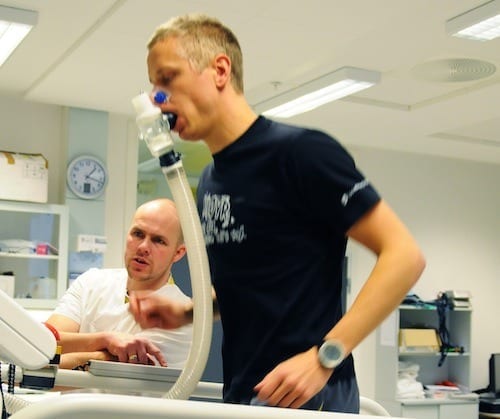
Regular training improves maximal oxygen uptake (VO2max), which is a well-established measure of physical fitness.
However, just how much exercise, and how intense that exercise should be to deliver the biggest benefit remains to be defined. Now, researchers from the KG Jebsen – Centre of Exercise in Medicine at the Norwegian University of Science and Technology (NTNU) in Trondheim have found that just three short high-intensity sessions (AIT) per week can make for substantial differences in the fitness of inactive men. Their results have just been published in PLOS ONE.
“Our data suggest that a single bout of AIT performed three times per week may be a time-efficient strategy to improve VO2max”, says Arnt Erik Tjønna, a postdoctoral fellow at the center and lead author of the study. Tjønna says one of the advantages of this approach is that it is easy for people to incorporate into their daily lives.
The researchers measured changes in VO2max and traditional cardiovascular risk factors in 24 inactive but otherwise healthy overweight men after they completed a 10-week training session that involved three weekly high-intensity interval sessions. One group of 13 followed a protocol that has previously shown to be effective, consisting of four intervals of 4 minutes of high intensity exercise at 90% of maximal heart rate (HRmax) interspersed with 3 minutes of active recovery at 70% HRmax (4-AIT), commonly known as 4×4 training.
The other group followed a protocol that consisted of one 4-minute interval at 90% HRmax (1-AIT).
After training, VO2max increased by 10% in the group that had just one high-intensity session three times a week (1-AIT), while the group that followed the 4×4 regime increased its VO2max by 13%. Both groups saw decreases in their blood pressure, but the 1-AIT the group’s blood pressures showed greater decreases than their 4-AIT counterparts for both systolic and diastolic readings.
The Latest Bing News on:
Short high-intensity sessions
- 15 Easy, Effective Workouts To Do on Vacationon May 6, 2024 at 8:00 am
A personal trainer breaks down 15 of his top-recommended easy and effective YouTube workouts to do on vacation.
- EMOM Workouts: A High-Intensity Interval Training Optionon May 6, 2024 at 7:10 am
It also keeps the workout and rest intervals within sufficient limits to provide a high-intensity workout." In other words, EMOMs are structured so you can adjust them to your abilities while ...
- Here's How Long You Need To Run Every Day for Weight Losson May 2, 2024 at 7:00 am
A personal trainer breaks down how long you need to run every day for weight loss, along with the benefits of this form of cardio.
- You only need 1 kettlebell and 6 moves to build full-body muscle with this strength-training workouton April 26, 2024 at 1:30 am
If you want to build muscle, you might imagine that you need a gym full of equipment to see results. Fortunately, that’s not the case, as you can strengthen your whole body, develop your core, and ...
- Follow This 4-Week Training Plan If You Want to Get Faster—Fast!on April 25, 2024 at 1:50 pm
Ready to crank up your average speed? This four-week training plan to get faster will have you clocking quicker paces in just one month.
- High-intensity warm-up before a marathon no better than gentle jog in improving endurance performance, research suggestson April 24, 2024 at 1:00 pm
Having a gentle jog before may be just as effective as a plyometric workout and may help athletes retain vital glyocen stores for longer.
- Does Electrical Muscle Stimulation Really Supercharge Your Workouts?on April 23, 2024 at 1:32 pm
Electrical muscle stimulation (EMS) workouts are having a moment—not for the first time, and probably not for the last—based on their futuristic vibes and the fitness industry’s constant quest to sell ...
- Best weightlifting shoes to get more out of your strength training sessionson April 16, 2024 at 11:47 am
Whether you're looking for a dedicated weightlifting shoe you can wear exclusively for powerlifting sessions or versatile ... Built for deadlifts and other high-intensity weightlifting, the ...
- Should you take up HIIT? The pros and cons of high intensity interval trainingon April 9, 2024 at 5:00 pm
is an interval training exercise that incorporates several rounds that alternate between several minutes of high intensity movements. The goal is to significantly increase the heart rate to at least ...
- Want a Lower-Impact Version of a HIIT Workout? Try HILIT (High-Intensity, Low-Impact) Trainingon December 20, 2023 at 6:11 pm
Short for high-intensity, low-impact exercise, HILIT offers short and intense intervals of work without the bounce. "You can still get your heart rate up similar to a regular HIIT session, and you'll ...
The Latest Google Headlines on:
Short high-intensity sessions
[google_news title=”” keyword=”short high-intensity sessions” num_posts=”10″ blurb_length=”0″ show_thumb=”left”]
The Latest Bing News on:
AIT
- What Do Airport Body Scanners Really See?on May 8, 2024 at 5:51 am
Sure, airport body scanners are looking for threats, but here’s what else these security devices might reveal in the process ...
- Ait Taleb answers to Parliament on mental health, emergency services and 'guarantee cheques'on May 7, 2024 at 11:47 am
Morocco’s healthcare sector is facing a number of major challenges that are hampering its efficiency and ability to meet the growing needs of the population. These include the persistent shortage of ...
- KPCIP, AIT Bangkok sign scholarship agreementon May 4, 2024 at 1:10 am
In a groundbreaking development, the Local Government Election & Rural Development Department, under the Asian Development Bank-funded Khyber-Pakhtunkhwa Cities Improvement Project (KPCIP), has ...
- Khyber Pakhtunkhwa Initiative: AIT Bangkok Partners With KPCIP To Empower Women Through Scholarshipson May 3, 2024 at 1:10 pm
In a transformative move aimed at empowering women in Khyber Pakhtunkhwa, the Local Government Election & Rural Development Department, under the As ...
- AIT Applied Industrial Technologies, Inc.on May 3, 2024 at 9:00 am
Applied Industrial Technologies, Inc. distributes industrial motion, power, control, and automation technology solutions in North America, Australia, New Zealand, and Singapore. It operates in two ...
- Defense mission and AIT ink service dealon May 3, 2024 at 9:00 am
The Ministry of National Defense’s Defense Mission to the US and the American Institute in Taiwan have signed a NT$518.2 million (US$16 million) continuing service agreement for the Maritime ...
- AIT Quantitative Stock Analysison April 27, 2024 at 12:05 pm
Below is Validea's guru fundamental report for APPLIED INDUSTRIAL TECHNOLOGIES INC (AIT). Of the 22 guru strategies we follow, AIT rates highest using our Twin Momentum Investor model based on the ...
- Rayan Ait-Nouri injury: Gary O’Neil issues update after Wolves draw vs Nottingham Foreston April 13, 2024 at 11:22 am
Gary O’Neil has revealed that Rayan Ait-Nouri missed Wolves’ 2-2 draw with Nottingham Forest after failing a late fitness test.
The Latest Google Headlines on:
AIT
[google_news title=”” keyword=”AIT” num_posts=”10″ blurb_length=”0″ show_thumb=”left”]










